Analyzing the Success of SAP ERP Project at IBM: Triple Constraints
VerifiedAdded on 2020/03/23
|6
|1150
|155
Report
AI Summary
This report provides an analysis of the success of IBM's SAP ERP project, emphasizing the importance of the triple constraints: time, cost, and performance. It explores how IBM managed these constraints to achieve project success, including the effective use of time estimation, budget feasibility studies, and employee training and development. The report highlights the value components such as consumer service, sustainability, and brand value that contributed to the project's positive outcomes. It also examines how the project manager successfully utilized resources to meet organizational and consumer needs, leading to reduced operational costs and improved service delivery. The successful implementation of the SAP ERP system allowed IBM to provide advanced services to both employees and consumers, ensuring functional and operational excellence.
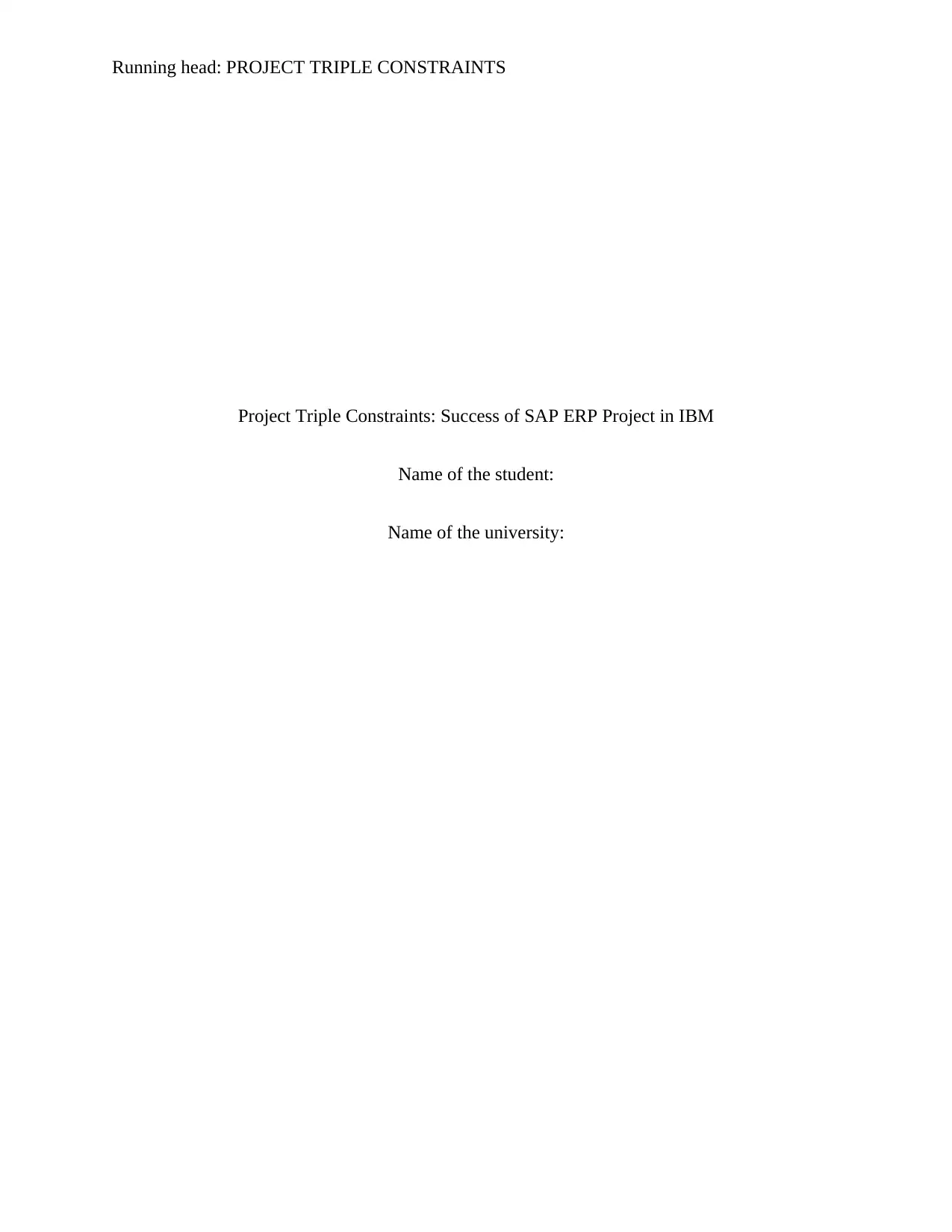
Running head: PROJECT TRIPLE CONSTRAINTS
Project Triple Constraints: Success of SAP ERP Project in IBM
Name of the student:
Name of the university:
Project Triple Constraints: Success of SAP ERP Project in IBM
Name of the student:
Name of the university:
Paraphrase This Document
Need a fresh take? Get an instant paraphrase of this document with our AI Paraphraser
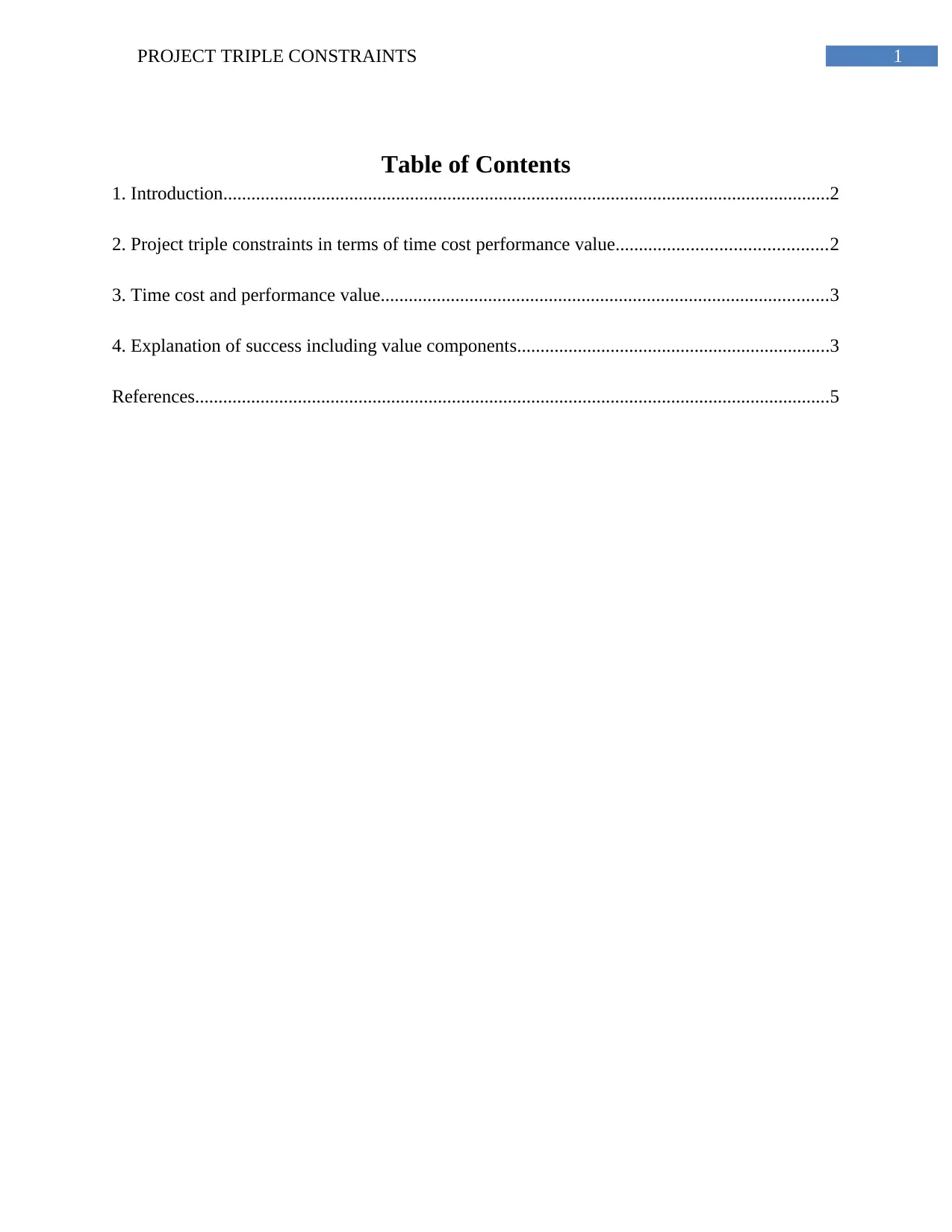
1PROJECT TRIPLE CONSTRAINTS
Table of Contents
1. Introduction..................................................................................................................................2
2. Project triple constraints in terms of time cost performance value.............................................2
3. Time cost and performance value................................................................................................3
4. Explanation of success including value components...................................................................3
References........................................................................................................................................5
Table of Contents
1. Introduction..................................................................................................................................2
2. Project triple constraints in terms of time cost performance value.............................................2
3. Time cost and performance value................................................................................................3
4. Explanation of success including value components...................................................................3
References........................................................................................................................................5
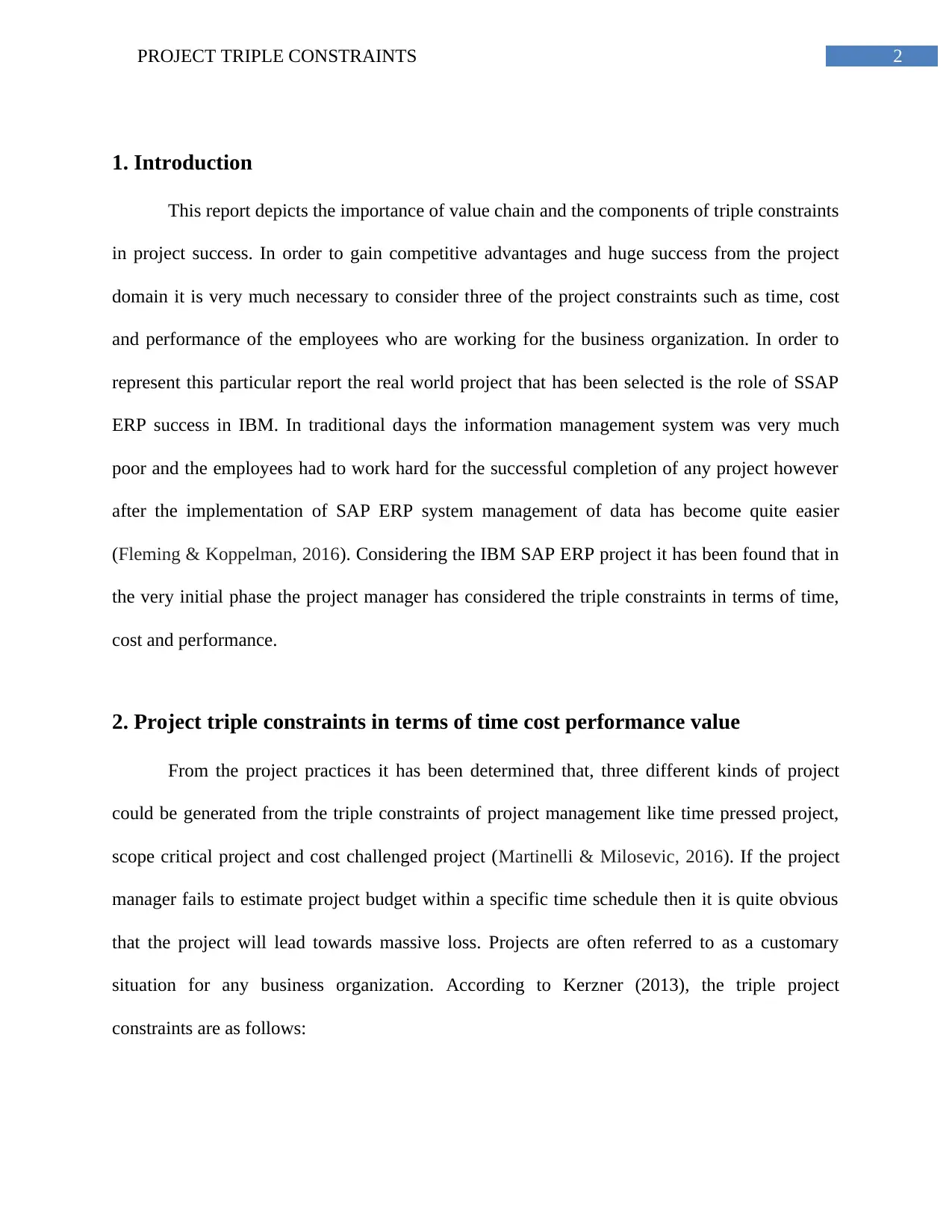
2PROJECT TRIPLE CONSTRAINTS
1. Introduction
This report depicts the importance of value chain and the components of triple constraints
in project success. In order to gain competitive advantages and huge success from the project
domain it is very much necessary to consider three of the project constraints such as time, cost
and performance of the employees who are working for the business organization. In order to
represent this particular report the real world project that has been selected is the role of SSAP
ERP success in IBM. In traditional days the information management system was very much
poor and the employees had to work hard for the successful completion of any project however
after the implementation of SAP ERP system management of data has become quite easier
(Fleming & Koppelman, 2016). Considering the IBM SAP ERP project it has been found that in
the very initial phase the project manager has considered the triple constraints in terms of time,
cost and performance.
2. Project triple constraints in terms of time cost performance value
From the project practices it has been determined that, three different kinds of project
could be generated from the triple constraints of project management like time pressed project,
scope critical project and cost challenged project (Martinelli & Milosevic, 2016). If the project
manager fails to estimate project budget within a specific time schedule then it is quite obvious
that the project will lead towards massive loss. Projects are often referred to as a customary
situation for any business organization. According to Kerzner (2013), the triple project
constraints are as follows:
1. Introduction
This report depicts the importance of value chain and the components of triple constraints
in project success. In order to gain competitive advantages and huge success from the project
domain it is very much necessary to consider three of the project constraints such as time, cost
and performance of the employees who are working for the business organization. In order to
represent this particular report the real world project that has been selected is the role of SSAP
ERP success in IBM. In traditional days the information management system was very much
poor and the employees had to work hard for the successful completion of any project however
after the implementation of SAP ERP system management of data has become quite easier
(Fleming & Koppelman, 2016). Considering the IBM SAP ERP project it has been found that in
the very initial phase the project manager has considered the triple constraints in terms of time,
cost and performance.
2. Project triple constraints in terms of time cost performance value
From the project practices it has been determined that, three different kinds of project
could be generated from the triple constraints of project management like time pressed project,
scope critical project and cost challenged project (Martinelli & Milosevic, 2016). If the project
manager fails to estimate project budget within a specific time schedule then it is quite obvious
that the project will lead towards massive loss. Projects are often referred to as a customary
situation for any business organization. According to Kerzner (2013), the triple project
constraints are as follows:
⊘ This is a preview!⊘
Do you want full access?
Subscribe today to unlock all pages.

Trusted by 1+ million students worldwide
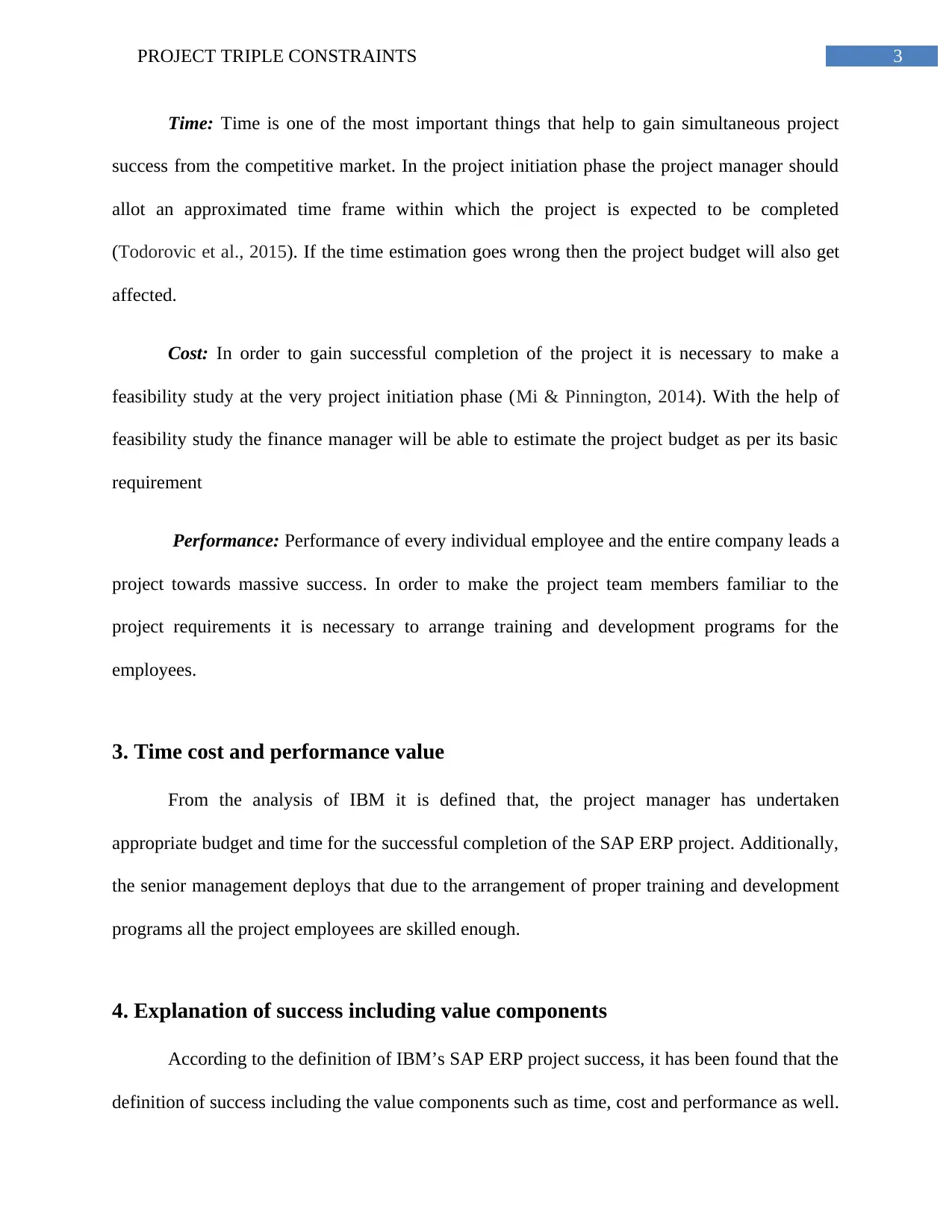
3PROJECT TRIPLE CONSTRAINTS
Time: Time is one of the most important things that help to gain simultaneous project
success from the competitive market. In the project initiation phase the project manager should
allot an approximated time frame within which the project is expected to be completed
(Todorovic et al., 2015). If the time estimation goes wrong then the project budget will also get
affected.
Cost: In order to gain successful completion of the project it is necessary to make a
feasibility study at the very project initiation phase (Mi & Pinnington, 2014). With the help of
feasibility study the finance manager will be able to estimate the project budget as per its basic
requirement
Performance: Performance of every individual employee and the entire company leads a
project towards massive success. In order to make the project team members familiar to the
project requirements it is necessary to arrange training and development programs for the
employees.
3. Time cost and performance value
From the analysis of IBM it is defined that, the project manager has undertaken
appropriate budget and time for the successful completion of the SAP ERP project. Additionally,
the senior management deploys that due to the arrangement of proper training and development
programs all the project employees are skilled enough.
4. Explanation of success including value components
According to the definition of IBM’s SAP ERP project success, it has been found that the
definition of success including the value components such as time, cost and performance as well.
Time: Time is one of the most important things that help to gain simultaneous project
success from the competitive market. In the project initiation phase the project manager should
allot an approximated time frame within which the project is expected to be completed
(Todorovic et al., 2015). If the time estimation goes wrong then the project budget will also get
affected.
Cost: In order to gain successful completion of the project it is necessary to make a
feasibility study at the very project initiation phase (Mi & Pinnington, 2014). With the help of
feasibility study the finance manager will be able to estimate the project budget as per its basic
requirement
Performance: Performance of every individual employee and the entire company leads a
project towards massive success. In order to make the project team members familiar to the
project requirements it is necessary to arrange training and development programs for the
employees.
3. Time cost and performance value
From the analysis of IBM it is defined that, the project manager has undertaken
appropriate budget and time for the successful completion of the SAP ERP project. Additionally,
the senior management deploys that due to the arrangement of proper training and development
programs all the project employees are skilled enough.
4. Explanation of success including value components
According to the definition of IBM’s SAP ERP project success, it has been found that the
definition of success including the value components such as time, cost and performance as well.
Paraphrase This Document
Need a fresh take? Get an instant paraphrase of this document with our AI Paraphraser
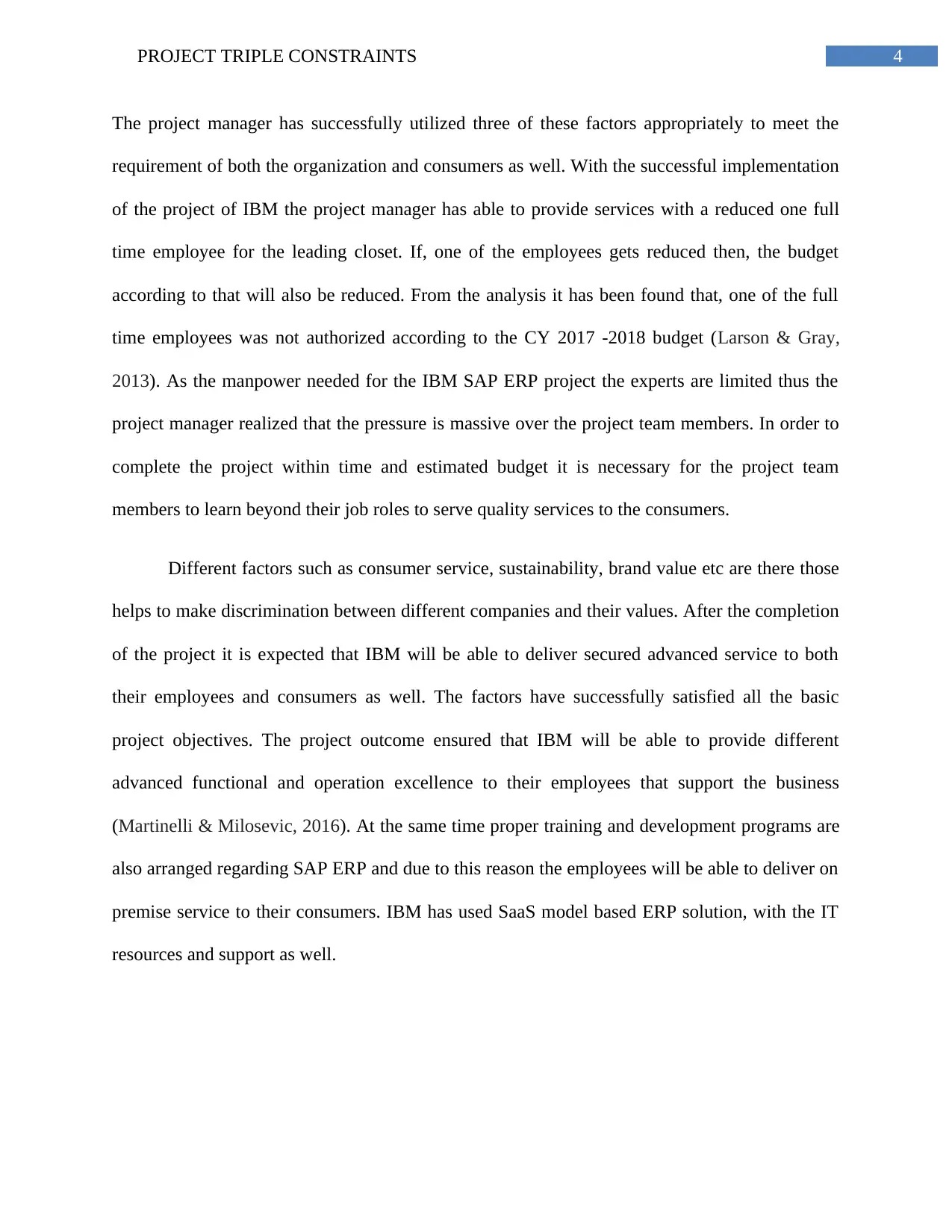
4PROJECT TRIPLE CONSTRAINTS
The project manager has successfully utilized three of these factors appropriately to meet the
requirement of both the organization and consumers as well. With the successful implementation
of the project of IBM the project manager has able to provide services with a reduced one full
time employee for the leading closet. If, one of the employees gets reduced then, the budget
according to that will also be reduced. From the analysis it has been found that, one of the full
time employees was not authorized according to the CY 2017 -2018 budget (Larson & Gray,
2013). As the manpower needed for the IBM SAP ERP project the experts are limited thus the
project manager realized that the pressure is massive over the project team members. In order to
complete the project within time and estimated budget it is necessary for the project team
members to learn beyond their job roles to serve quality services to the consumers.
Different factors such as consumer service, sustainability, brand value etc are there those
helps to make discrimination between different companies and their values. After the completion
of the project it is expected that IBM will be able to deliver secured advanced service to both
their employees and consumers as well. The factors have successfully satisfied all the basic
project objectives. The project outcome ensured that IBM will be able to provide different
advanced functional and operation excellence to their employees that support the business
(Martinelli & Milosevic, 2016). At the same time proper training and development programs are
also arranged regarding SAP ERP and due to this reason the employees will be able to deliver on
premise service to their consumers. IBM has used SaaS model based ERP solution, with the IT
resources and support as well.
The project manager has successfully utilized three of these factors appropriately to meet the
requirement of both the organization and consumers as well. With the successful implementation
of the project of IBM the project manager has able to provide services with a reduced one full
time employee for the leading closet. If, one of the employees gets reduced then, the budget
according to that will also be reduced. From the analysis it has been found that, one of the full
time employees was not authorized according to the CY 2017 -2018 budget (Larson & Gray,
2013). As the manpower needed for the IBM SAP ERP project the experts are limited thus the
project manager realized that the pressure is massive over the project team members. In order to
complete the project within time and estimated budget it is necessary for the project team
members to learn beyond their job roles to serve quality services to the consumers.
Different factors such as consumer service, sustainability, brand value etc are there those
helps to make discrimination between different companies and their values. After the completion
of the project it is expected that IBM will be able to deliver secured advanced service to both
their employees and consumers as well. The factors have successfully satisfied all the basic
project objectives. The project outcome ensured that IBM will be able to provide different
advanced functional and operation excellence to their employees that support the business
(Martinelli & Milosevic, 2016). At the same time proper training and development programs are
also arranged regarding SAP ERP and due to this reason the employees will be able to deliver on
premise service to their consumers. IBM has used SaaS model based ERP solution, with the IT
resources and support as well.
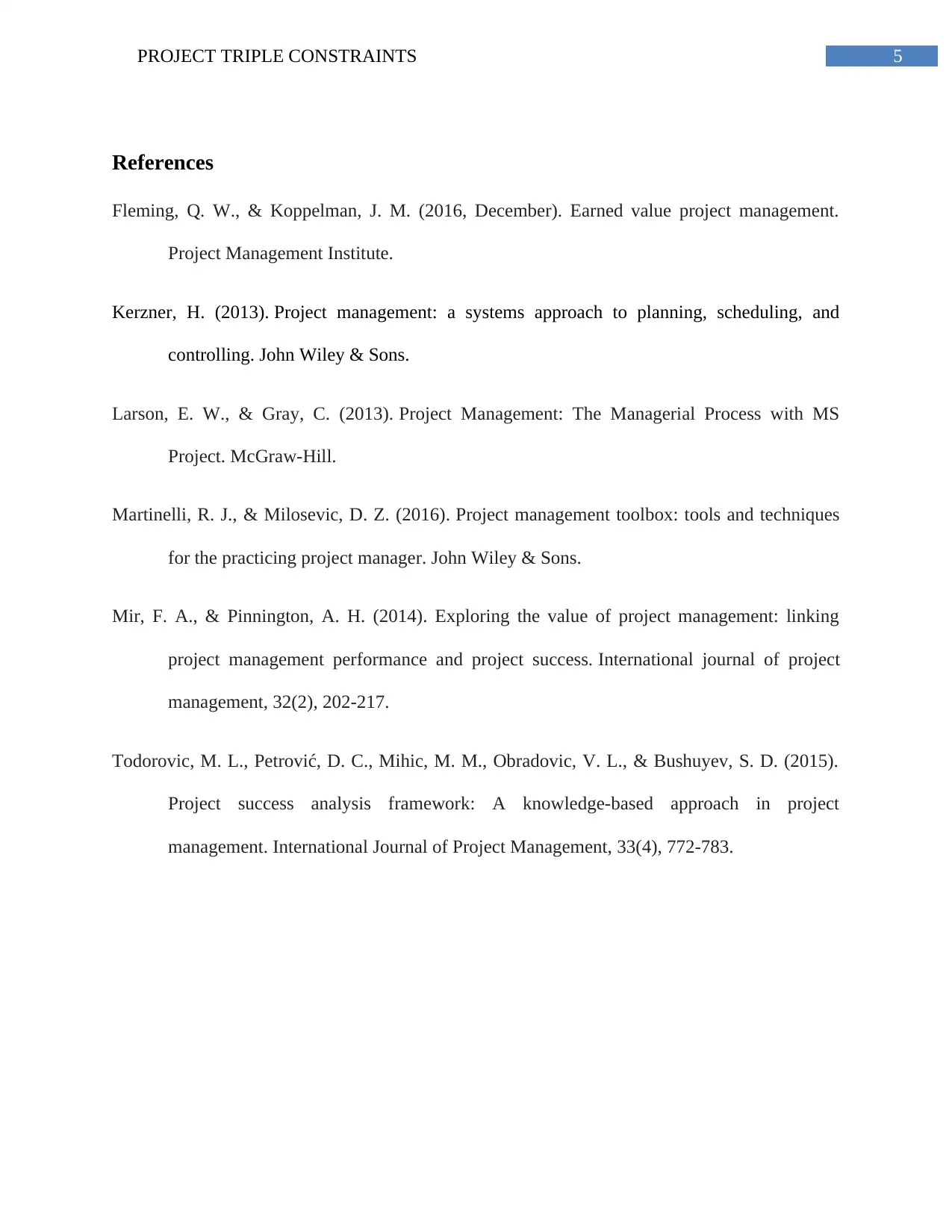
5PROJECT TRIPLE CONSTRAINTS
References
Fleming, Q. W., & Koppelman, J. M. (2016, December). Earned value project management.
Project Management Institute.
Kerzner, H. (2013). Project management: a systems approach to planning, scheduling, and
controlling. John Wiley & Sons.
Larson, E. W., & Gray, C. (2013). Project Management: The Managerial Process with MS
Project. McGraw-Hill.
Martinelli, R. J., & Milosevic, D. Z. (2016). Project management toolbox: tools and techniques
for the practicing project manager. John Wiley & Sons.
Mir, F. A., & Pinnington, A. H. (2014). Exploring the value of project management: linking
project management performance and project success. International journal of project
management, 32(2), 202-217.
Todorovic, M. L., Petrović, D. C., Mihic, M. M., Obradovic, V. L., & Bushuyev, S. D. (2015).
Project success analysis framework: A knowledge-based approach in project
management. International Journal of Project Management, 33(4), 772-783.
References
Fleming, Q. W., & Koppelman, J. M. (2016, December). Earned value project management.
Project Management Institute.
Kerzner, H. (2013). Project management: a systems approach to planning, scheduling, and
controlling. John Wiley & Sons.
Larson, E. W., & Gray, C. (2013). Project Management: The Managerial Process with MS
Project. McGraw-Hill.
Martinelli, R. J., & Milosevic, D. Z. (2016). Project management toolbox: tools and techniques
for the practicing project manager. John Wiley & Sons.
Mir, F. A., & Pinnington, A. H. (2014). Exploring the value of project management: linking
project management performance and project success. International journal of project
management, 32(2), 202-217.
Todorovic, M. L., Petrović, D. C., Mihic, M. M., Obradovic, V. L., & Bushuyev, S. D. (2015).
Project success analysis framework: A knowledge-based approach in project
management. International Journal of Project Management, 33(4), 772-783.
⊘ This is a preview!⊘
Do you want full access?
Subscribe today to unlock all pages.

Trusted by 1+ million students worldwide
1 out of 6
Related Documents
Your All-in-One AI-Powered Toolkit for Academic Success.
+13062052269
info@desklib.com
Available 24*7 on WhatsApp / Email
![[object Object]](/_next/static/media/star-bottom.7253800d.svg)
Unlock your academic potential
Copyright © 2020–2025 A2Z Services. All Rights Reserved. Developed and managed by ZUCOL.





